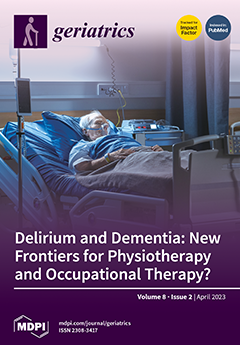Background: Comprehensive geriatric care (CGC) is a multiprofessional treatment for older people which considers medical conditions and functional status. The aim of the presented study is to investigate the impact of hypertensive blood pressure (BP) on functional outcomes among older adults receiving CGC. Methods: Functional status was documented by the Barthel index (BI), Tinetti test (TBGT), and timed up and go test (TUG) prior to and after CGC. The results were analyzed in relation to hypertensive BP, indicated by mean BP ≥ 130/80 mmHg determined by 24 h blood pressure monitoring (BPM) while hospitalized. Results: In the presented monocentric, retrospective, observational study, 490 patients were included (mean age (SD): 83.86 ± 6.17 years, 72.2% females). Hypertension in BPM was found in 302 (61.6%) individuals. Hypertensive BP was associated with the female sex (
p < 0.001) and current fracture (
p = 0.001), and inversely associated with heart failure (
p < 0.001), coronary heart disease (
p < 0.001), atrial fibrillation (
p < 0.001), urinary tract infection (
p = 0.022), and hypocalcemia (
p = 0.014). After CGC, improvements in BI (
p < 0.001), TBGT (
p < 0.001), and TUG (
p < 0.001) were observed in patients with both normotensive and hypertensive BP profiles. The proportion of patients with outcome improvements did not differ between the two groups (BI: 84.4% vs. 88.3%,
p = 0.285; TBGT: 81.1% vs. 77.7%,
p = 0.357; TUG: 50.3% vs. 48.4%,
p = 0.711). Conclusion: Patients both with and without hypertensive BP profiles benefited from comprehensive geriatric care with comparable outcome improvements. Particularly, normotensive BP was associated with chronic cardiovascular comorbidities, indicating increased awareness of the importance of BP management in patients diagnosed with cardiac diseases.
Full article






